Grape Phylloxera and its Effect on the Wine Industry
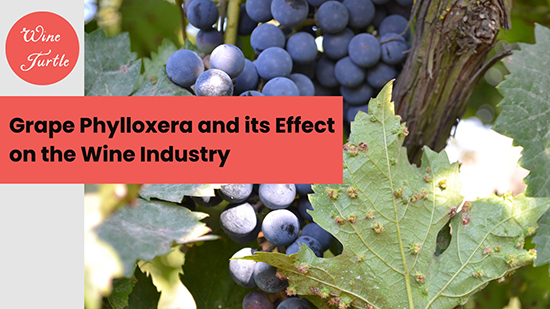
Climate change presents a real threat to the wines we know and love but it's not the first time the wine industry faced a real crisis.
In today's article, I tell the story of The Great French Wine Blight of the late 1800s and the insect that brought the European wine industry to the brink of disaster.
What is Grape Phylloxera?
Grape Phylloxera played the villain in one of the most infamous tales in the history of wine and I'll tell the story in this article.
But, first let's learn what they are and why they're so devilish.
This minuscule pest, also known as the grape louse or scientifically as Dactylosphaera vitifoliae, has had a profound impact on the world of wine, shaping the industry in ways that are still felt today.
Grape Phylloxera is a small, yellowish insect that feeds on the roots of Vitis vinifera grapevines.
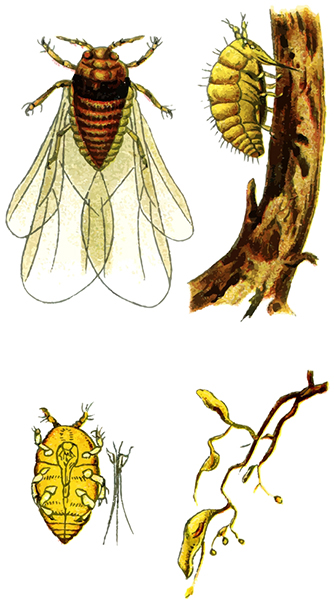
Grape Phylloxera in its two forms
Originating in North America, it's adapted to feed on native American grape species, which have evolved resistance to the pest.
However, when brought into contact with the European grape species Vitis vinifera, the primary species used for wine production, the results can be devastating.
The European grapevines have no natural defense against Phylloxera, making them highly susceptible to infestation.
The life cycle of the wine disease we call Phylloxera is complex and involves multiple stages, including a form that lives and feeds on the grapevine roots and another that lives on the leaves and lays eggs.
The root-feeding form is the most damaging, as it creates nodules on the roots that can eventually kill the vine. The egg laying adult doesn't feed on the plant but lays hundreds of eggs on the leaves, which ensure the plant is consigned to lots more damage when the nymphs emerge and feast on the roots.
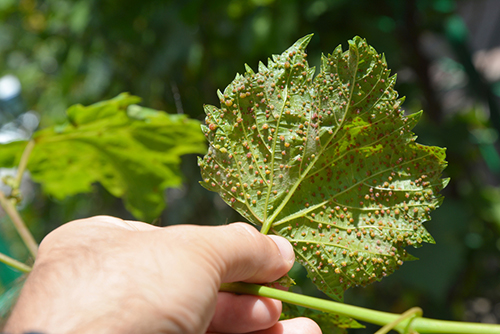
A leaf affected by Phylloxera
The impact of Phylloxera on grapevines is not immediate. Infected vines can continue to produce grapes for several years before the damage to the roots becomes severe enough to kill the vine.
This slow progression of the disease can make it difficult to detect and control Phylloxera outbreaks.
In the next sections, we'll delve into the historical impact of the Phylloxera epidemic, particularly the Great French Wine Blight of the 19th century, and discuss modern strategies for preventing and controlling this persistent pest that wants to take our wine!
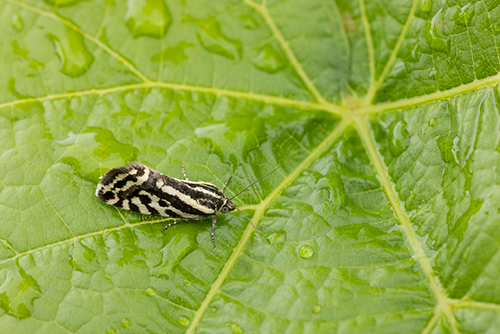
Adult Phylloxera on a leaf
The Great French Wine Blight
The Great French Wine Blight is a tale of woe and despair, but also one of resilience and innovation.
It's a story that has been etched into the annals of wine history, a stark reminder of the fragility of the industry we so love.
The year was 1863 and a mysterious disease began to sweep through the vineyards of France.
Vines that had once flourished were now withering and dying, their leaves turning a sickly yellow before falling off completely.
The grapes, once plump and juicy, shriveled on the vine. The French wine industry, a cornerstone of the country's economy and culture, was under siege.
The culprit?
Our tiny friend, the Grape Phylloxera!
Unbeknownst to the wine grape growers of the time, this little louse had stowed away on imported American vines and found a new, defenseless host in the European grapevines.
The result was catastrophic.
By the 1880s, nearly 40% of French vineyards had been decimated by the blight. The French wine industry was on the brink of collapse.
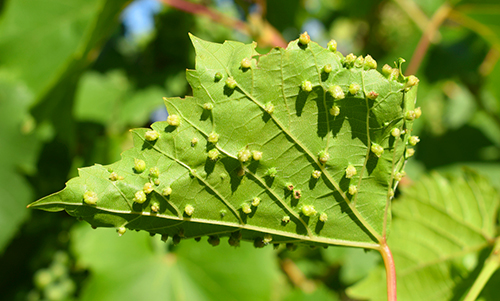
Leaf affected by Phylloxera infestation
But let's not dwell on the doom and gloom. For in the face of adversity, the human spirit often shines the brightest. And shine it did.
The solution to the Phylloxera crisis came in the form of American rootstocks.
These rootstocks, naturally resistant to Phylloxera, were grafted onto European vines.
The result?
Vines that produced the high-quality grapes the industry was known for, but with the added benefit of Phylloxera resistance.
The Great French Wine Blight was a turning point in the wine industry. It forced vignerons to think innovatively, to adapt and overcome. It was a stark reminder of the delicate balance of nature, and the impact that a single, tiny insect can have on an entire industry.
The Great French Wine Blight could have been the end, but instead, it was a new beginning.
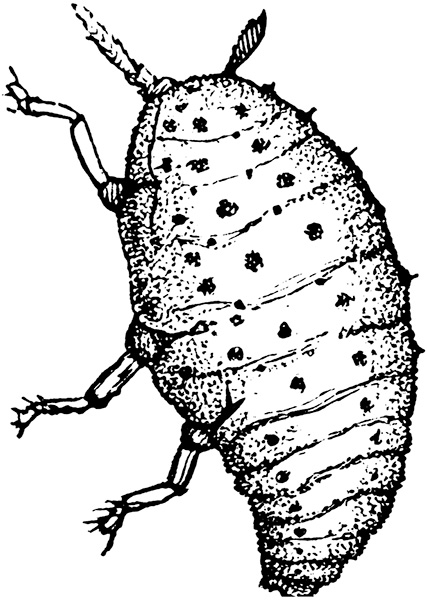
Phylloxera grape louse that feeds on roots of vines
How Did Phylloxera Spread? (Causes of Phylloxera Infestations)
Now, let's delve into the intricacies of how this tiny pest, the Phylloxera, managed to spread its reign of terror across vineyards. It's a tale of movement and survival, a testament to the adaptability of nature's smallest creatures.
Phylloxera, much like any other living organism, has a knack for survival. It's a root louse, meaning it thrives in the soil, feasting on the roots of grapevines. But it doesn't just stay put. No, this little creature has a rather ingenious method of spreading.
You see, Phylloxera has two forms - one that attacks the roots and another that attacks the leaves. The leaf form, known as the 'winged form', has the ability to fly from vine to vine, laying eggs as it goes.

Stages of Phylloxera infestation
Nymphs emerge from the eggs and burrow into the soil to feast on the roots of the new host vine. It's a cycle of destruction that's as efficient as it is devastating.
But the spread of Phylloxera isn't just down to its biology. Human intervention played a significant role too.
In the 19th century, the practice of shipping vines around the world was common. Vines from America, where Phylloxera is native, were sent to Europe, unknowingly carrying the pest with them.
Once in Europe, the Phylloxera found a new host in the European grapevines, which had no natural defenses against it.
The spread of Phylloxera is a stark reminder of the delicate balance of ecosystems. It's a lesson in the unintended consequences of human actions, and the devastating impact a tiny creature can have when introduced to a new environment.
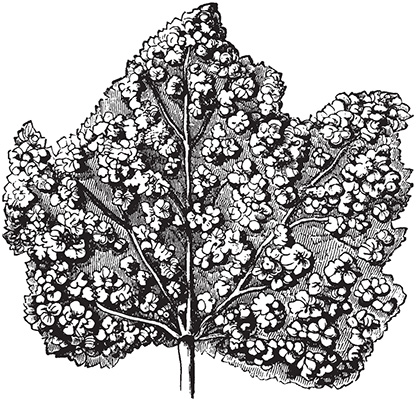
Phylloxera eggs on a leaf
How Was the French Wine Industry Saved?
In the late 19th century, the French wine industry faced a devastating crisis. Vines were dying en masse, and the cause was a mystery.
In 1868, desperate grape growers in the Rhône Valley sought help from a Montpellier agricultural society. A committee was formed to save the wine industry.
They're first crucial discovery was to find tiny insects, or "lice," on the roots of affected vines, that were sapping the life from the plants.
Meanwhile, across the Atlantic, Charles Valentine Riley, an American entomologist, had been tracking the news in France.
He sent examples of American grape lice to French entomologist Victor Antoine Signoret, who confirmed in 1870 that they were identical to the French pest.
This was a significant breakthrough, but it also posed a new puzzle: the American lice were known to infest only the leaves of vines, while the French lice infested the roots.
Riley made another crucial discovery: American lice also wintered on the roots of American grapevines, causing damage, though less severe than in French vines.
This finding confirmed the identity of both the French grape lice and its American relative. However, in France the consensus still asserted that Phylloxera was not the reason, but rather a symptom of an underlying, yet undiscovered, disease.
Despite this controversy, Riley had identified American varieties of grapevines that were Phylloxera resistant. Starting in 1871, French farmers hurriedly began importing these varieties and grafting their own vines onto the American rootstock.
However, this was not an immediate solution, as some of these American grapevines could not adapt to the chalkier soil in France and were affected by the dreaded Phylloxera anyway.
However, basically by a process of elimination, eventually American vines were identified that were happy in these unfamiliar soils.
While this was happening, entomologists were working to understand the complex stages of life of Phylloxera. It wasn't until 1874 that the lice's complicated cycle of life was finally understood.

How Serious Was the Phylloxera Threat to the Wine Industry?
Let's take a moment to truly grasp the magnitude of the Phylloxera crisis. It wasn't just a blight, a pest, a nuisance. No, it was a catastrophe that shook the very foundations of the wine industry, particularly in Europe.
The economic impact was staggering. Wine production plummeted, vineyards were abandoned, and countless jobs were lost. The wine industry, which had been a cornerstone of the European economy, was in ruins. The cost of the crisis, in today's terms, would run into billions of dollars.
But the impact of Phylloxera went beyond the economic. It struck at the very heart of European culture. Wine is more than just a product in Europe; it's a way of life, a symbol of national pride, a link to the past. The loss of the vineyards was a cultural tragedy, a blow to the European identity.
And yet, in the face of this crisis, the wine industry did not crumble. It adapted, it evolved, it survived. The grafting of American rootstocks onto European vines, as I mentioned earlier, was a crucial part of this survival.
But it was also the resilience of the people - the winemakers, the vineyard workers, the consumers - that saw the industry through this crisis.
Prevention and Control Strategies for Modern Day Phylloxera Outbreaks
As we journey into the present day, we find ourselves in a world where the ghost of Phylloxera still lingers, but we are far from powerless against it.
The lessons of the past have equipped us with an arsenal of strategies to prevent and control Phylloxera outbreaks, ensuring the survival and prosperity of our beloved vineyards.
At the forefront of these strategies is the continued use of resistant rootstocks.
These hardy warriors, born from the union of European vines and American rootstocks, stand as our first line of defense against Phylloxera. They are the living testament to our resilience and adaptability, a symbol of our triumph over adversity.
But our battle against Phylloxera does not end with resistant rootstocks. We have also developed sophisticated quarantine measures to prevent the spread of this pest.
To prevent the spread of Phylloxera, many regions implement strict quarantine measures. This includes inspecting all imported vines and restricting the movement of potentially infested soil or plant material.
In addition to these, we have also embraced modern pest control techniques and disease prevention strategies.
From biological control methods that use natural predators of Phylloxera, to advanced vineyard management practices that promote the health and vitality of our vines, we are constantly innovating and evolving in our fight against this pest.
Many natural predators of Phylloxera exist but only a few actually target the root-feeding variety that affects grapevines. However, there is still lots of research ongoing in the area.
